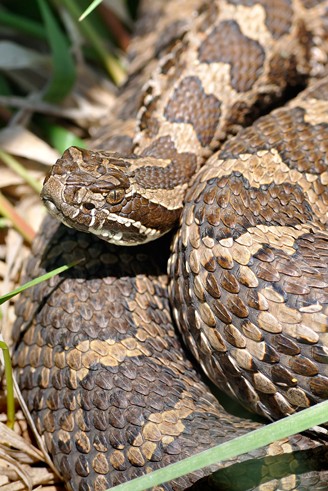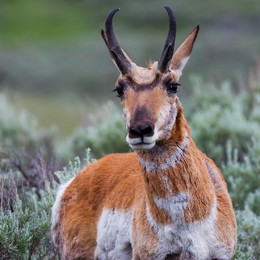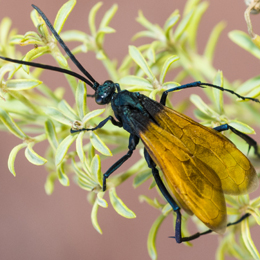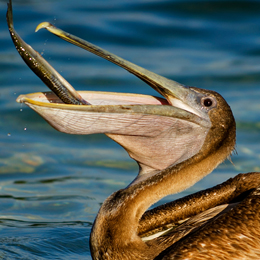Physical Description
The Massasauga Rattlesnake often inhabits wetland zones near the Great Lakes or can be found basking near river mouths. This swamp rattlesnake often changes its habitat depending upon environmental factors like temperature and terrestrial biomass.
It requires particular micro-habitat features to survive, adapt and reproduce.
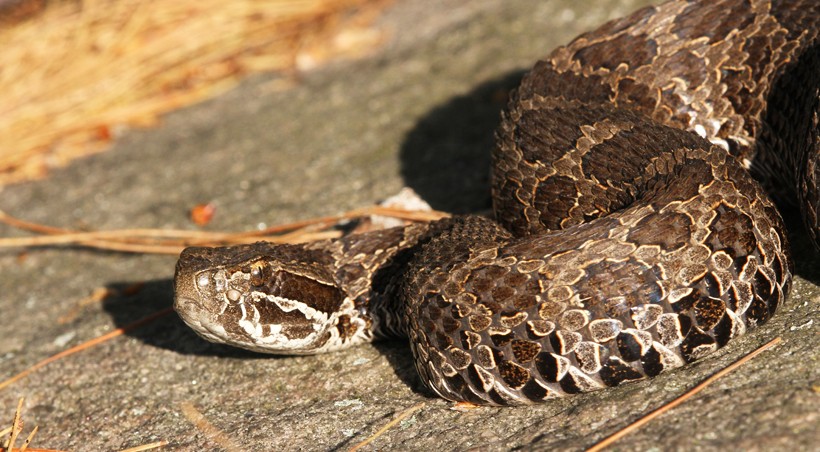
With a length up to 80 cm, the Eastern Massasauga Snake is the largest of the subspecies
?
Image credits: Kyle Horner/Shutterstock
Like all pit vipers, the Massasauga rattlesnake contains large fangs at the front of the mouth, used for injecting a lethal dose of venom during a hunt or when the snake feels threatened.
They are medium sized, hetero-thermic snakes, with a body that is covered in black blotches. All species of the massasauga rattlesnake have 25 rows of scales at the mid body and 9 enlarged scales present on the triangular head.
Measuring about 45 – 80 cm in length (1.5 – 2.6 ft), the species occupies an approximate weight of 300 - 400 grams (0.6 - 0.8 lbs).
This venomous snake that belongs to the pit viper family consists of heat-sensing pits that are very useful during a hunt.
Habitat
The constant habitat change that takes place in a Massasauga Rattlesnake’s lifecycle shows just how picky this species can be.
They usually inhabit bottomland forests, wetland seclusions like swamps, bogs and marshy floodplains. The snake generally moves to a drier habitat like grasslands during early spring and throughout their summer months.
Also known as the pygmy rattlesnake, the Massasauga rattlesnake has become a well-preserved species in North America due to recent population decline.
Basic Anatomy
The Massasauga Rattlesnake is quite distinguishable by the presence of multiple blotches or irregularly shaped stripes that run along its medium-sized body.
The snake is usually dark brown colored with dark stripes on its tail that is often outlined by a lighter row. This species is strikingly beautiful, lethal and a potent killer with a black belly and a triangular shaped head.
While the scales consist of a raised ridge at the center, the rattle or series of hollow segments on the tail of the Massasauga rattlesnake gives it a dangerous appeal. The number of segments of the rattle is a useful factor that can indicate the actual age of the snake.
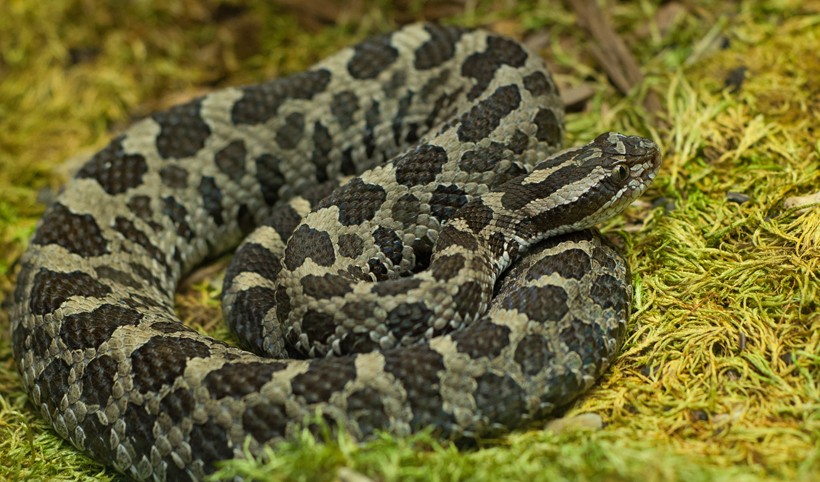
Eastern Massasauga Rattlesnake
?
Image credits: Gerald A. DeBoer/Shutterstock
- Eastern Massasauga Rattlesnake (Sistrurus catenatus catenatus)
This species of the Massasauga rattlesnake is the only venomous snake in Michigan that has vertical pupils, heat sensing pits and a beautifully blotched outline. Though it prefers to avoid detection, wildlife biologists have observed that this snake is sluggish in its movement, thick-bodied and showcases a dark brown body with rectangular patches that contrast against a light gray skin tone.
Found mainly in the Lower Peninsula, the snakes retire near the Great Lakes, forming their nests in a rodent burrow/rabbit hole.
This species of the Massasauga rattlesnake is the only venomous snake in Michigan that has vertical pupils, heat sensing pits and a beautifully blotched outline. Though it prefers to avoid detection, wildlife biologists have observed that this snake is sluggish in its movement, thick-bodied and showcases a dark brown body with rectangular patches that contrast against a light gray skin tone.
Found mainly in the Lower Peninsula, the snakes retire near the Great Lakes, forming their nests in a rodent burrow/rabbit hole.
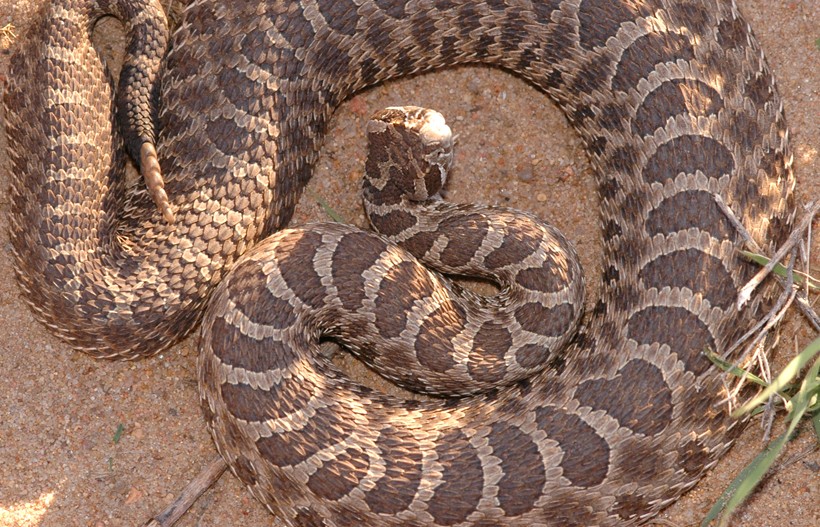
Western Massasauga Rattlesnake
?
Image credits: Rusty Dodson/Shutterstock
- Western Massasauga Rattlesnake (Sistrurus catenatus tergeminus)
Also known as the sand rattler, the Western Massasauga Rattlesnake is smaller in comparison to its Eastern relative, with short fangs that measure about 4.5-6 mm in length.
You can easily distinguish 25 rows of scales that run mid length on its lightly colored body. The dark brown blotches present around the sides and the light underbelly makes it easy for the snake to camouflage itself.
Particularly located on plains and rocky outcrops, this species lures its prey using its rattle.
Also known as the sand rattler, the Western Massasauga Rattlesnake is smaller in comparison to its Eastern relative, with short fangs that measure about 4.5-6 mm in length.
You can easily distinguish 25 rows of scales that run mid length on its lightly colored body. The dark brown blotches present around the sides and the light underbelly makes it easy for the snake to camouflage itself.
Particularly located on plains and rocky outcrops, this species lures its prey using its rattle.
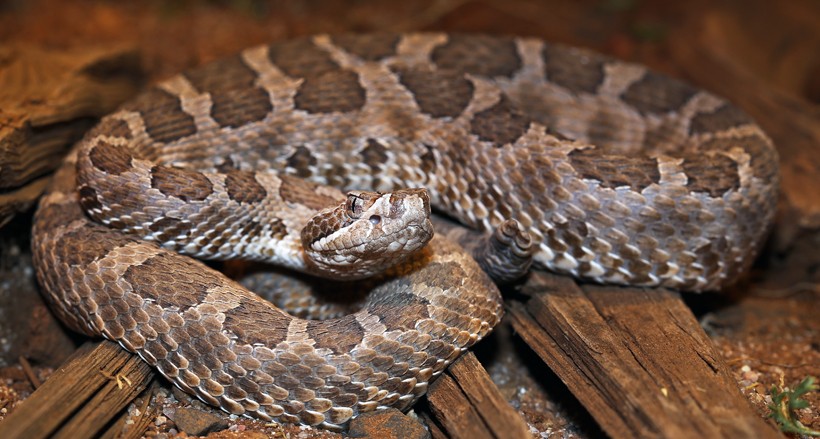
Desert Massasauga Rattlesnake
?
Image credits: Ryan M. Bolton/Shutterstock
- Desert Massasauga Rattlesnake (Sistrurus catenatus edwardsii)
This heavy bodied species is primarily found in deserts or semi-arid regions that showcase a light grey coloring. Also marked by dark brown stripes/blotches, these are often outlined in black leading to the formation of cross bands that give it a distinctive appeal.
Another distinguishable feature of the snake is the stripes present on each side of the head that runs downward towards the jaw.
This heavy bodied species is primarily found in deserts or semi-arid regions that showcase a light grey coloring. Also marked by dark brown stripes/blotches, these are often outlined in black leading to the formation of cross bands that give it a distinctive appeal.
Another distinguishable feature of the snake is the stripes present on each side of the head that runs downward towards the jaw.
Geographical Distribution
Out of the three subspecies, the Eastern Massasauga rattlesnake is the more familiar and popular due to its wide distribution in North America. Found throughout Central America, the habitat stretches from southern Canada to the west of Arizona. The Gulf Coast of Texas and eastern Pennsylvania are also territories assigned to the Eastern Massasauga rattlesnake, a habitat which is primarily close to water bodies and wet prairies.
The Western Massasauga rattlesnake also known as Edward’s rattlesnake is situated in the southwestern plains of the US, usually occupying hilly terrains and open grasslands between the Rocky Mountains and the Mississippi River. Southeast Nebraska and northwest of Missouri are the prominent areas where the subspecies can be found though its distribution can extend till west-central Oklahoma, central and northern Texas and southwest of the Colorado River.
The Desert Massasauga rattlesnake is an interesting subspecies of the genus Sistrurus that is native to parts of Mexico, primarily the Chihuahuan Desert and northern Texas. Pale white in color with virtually no marks present on its belly, this snake is a smaller version of its subspecies that is exclusively found in southeastern Arizona, San Jose Island, and central New Mexico. The habitat of the Desert Massasauga rattlesnake stretches till the Gulf Coast countries, into the Rio Grande Valley and as far as the north of Brazoria.
Diet
According to research, the typical diet of a Massasauga rattlesnake consists of rodents, lizards and insects. The potent venom of the pit viper makes it a lethal assassin that can easily hunt down prey using a number of primary senses. The species usually wanders into agricultural patches where it hunts small rodents like shrews, field mice and white-footed mice. Other small warm-blooded species include moles, bird eggs and amphibians like frogs and salamanders.
Prey
It is quite fascinating to watch a Massasauga rattlesnake hunt because it uses a meticulous procedure to catch its prey in the wild. The species can locate their prey using a sensory organ known as the Jacobson’s organ lying close to the nasal bone. This organ of chemoreception collects airborne particles and conveys a sensory message that helps the snake decipher the precise size and distance of the prey.
The species also relies on its thermal pits for infrared detection. This allows the Massasauga rattlesnake to hunt during the dark without relying on olfactory senses and instead use the heat-sensitive pits to locate the prey.
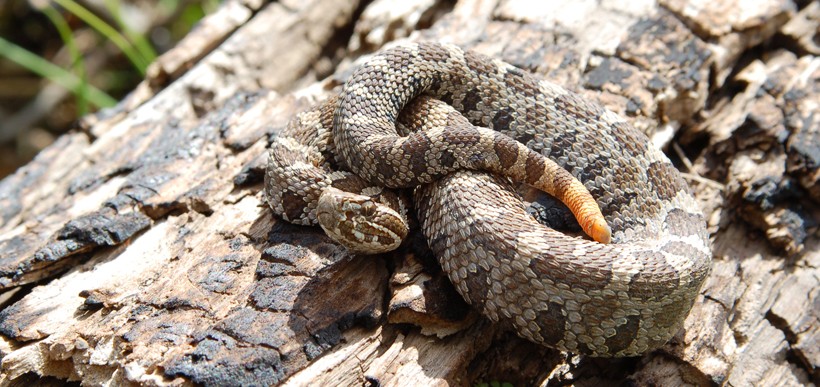
Massasauga Rattlesnakes can hide themselves perfectly in their natural environment.
?
Image credits: Gerald A. DeBoer/Shutterstock
The Massasauga Rattlesnake can easily camouflage its body with the surroundings, especially leaf litter where it stays hidden and waits for its prey’s arrival. Although they cannot strike above 30 cm, the snake is a potent killer due to its venom.
A small quantity of this modified saliva is enough to paralyze the prey. While biting, the fangs spring forward and jab the prey injecting the hemotoxin deep within and killing the prey within seconds.
The rattle segments of the pit viper species can be used to threaten a potential predator or attract a mate during breeding season. On an average, an adult Massasauga rattlesnake carries 30 – 31 mg of venom releasing around 5 – 6 mg per bite.
Predator
Commonly found predators that hunt down young Massasauga rattlers are bigger snakes like the Black Racer and the Milk snake. Raccoons, hawks and red-tailed foxes are also natural predators of this species that aren’t affected by its lethal venom.
However, the most dangerous predator of the Massasauga rattlesnake is humans, who have become its greatest threat for a number of reasons.
Threats
The biggest threat that the Massasauga rattlesnake faces is habitat loss due to consistent industrialization. In Nebraska, a devastating loss of native prairies due to the introduction of agricultural patches has exposed many Massasauga rattlesnakes to humans. This has led to massive killing since the snake is considered to be a threat because of its venomous and lethal bite.
They’re considered endangered in Canada and are listed as threatened or of special concern in most states of the United States.
Another massive threat that the Edmond’s rattlesnake (Western) faces is overgrazing of the grasslands due to which the snake is exposed to dangerous predators.
Loss of ground cover or foliage decreases the snake’s ability to camouflage itself thereby disrupting its hunting cycles and exposing nests to poachers.
This is constantly referred to as ‘Predation’ that is a major cause of mortality for the Western Massasauga rattlesnakes. As more trees invade the prairies, this gives raptors more perches to hunt for the rattlers.
Reproductive Cycle
The breeding season of this species begins in the spring and can sometimes also take place during the fall. The mating process is an intricate display of wooing a female Massasauga rattler that is most often observed with the Desert Massasauga rattlesnake. A male desert Massasauga rattlesnake associates romance during courtship by rubbing its chin on the forehead and neck of the female while looping its tail over hers as an affectionate gesture.
During gestation, a female Massasauga doesn’t consume a lot of food and instead depends upon fat reserves. The purpose is to conserve energy which decreases any possibilities of facing predators in the wild.
Since the rattlesnake falls prey to larger snakes, a female must find suitable dens to secure the nest, maintain temperature and speed the development of the embryos within her body. The amount of sun basking of the female does actually affects the incubation period that can be between two to four months.
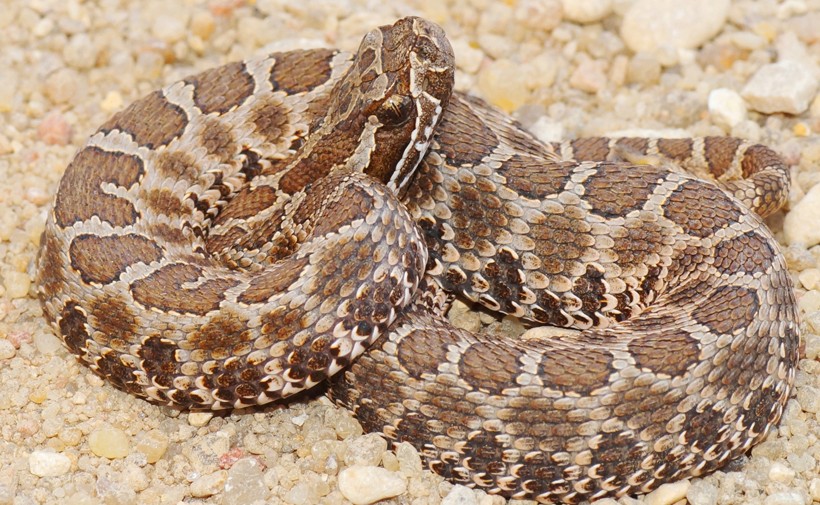
The amount of sun basking of the female rattlesnake accelerates the development of the embryos
?
Image credits: Matt Jeppson/Shutterstock
Despite being secretive, a female actually conveys she is ready to mate in a distinctive manner. She sheds her old skin, releasing pheromones into the air that attracts males.
The female gives normally birth during the month of August or early September. Like all pit vipers, a female Massasauga rattlesnake is oviparous and maintains a gestation period of three and a half months. Although females reproduce only once a year, the brood consists of about 5-20 young rattlers.
Baby rattlers have an average length of 18 – 25 cm (0.5 – 0.8 ft) and have a similarly shaped body with the distinctive black/dark brown blotches. The base or tip of the tail consists of a button from where the rattle or first segment starts to form.
Although young Massasauga rattlesnakes stay with their mother at the beginning, they soon disperse and begin to hunt on their own. The venom released by baby rattlers is more lethal since they’re unable to control the amount they actually inject during a bite.
Behavior
The Massasauga rattlesnake lives a sedentary life and remains active from April till late October.
The species hibernates during winters in small burrows often left abandoned by crayfish, rabbits or rodents. Usually, they seek out hibernation spots in lowland habitats that are quite close to the water but well below the frost line.
They are known to be good swimmers and can easily hunt for prey till a certain depth. The snake often returns to the same hibernation site year after year unless it has already been occupied by a higher species. These elegant creatures are quite useful since they help control pest population in agricultural fields.
During the summer months, the species is quite active early morning and late evening to avoid the scorching heat of the sun. They are diurnal in nature and tend to live a solitary life. However during the breeding season, they are known to communicate exclusively. Using chemical and physical signals, the rattlesnake can detect changes in the environment.
Bulky, docile and quite timid, the Massasauga is quite picky in terms of its mate and also the kind of nest it inhabits.
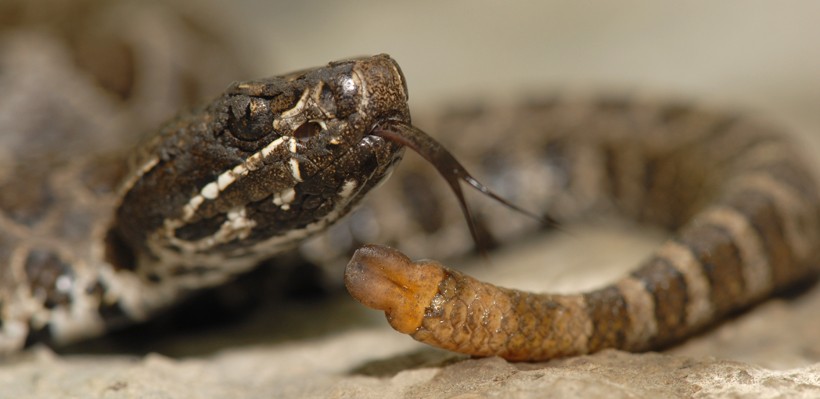
The sound of aggressive rattling indicates strike. However you will not hear this newborn, he has only one hollow segment!
?
Image credits: Rusty Dodson/Shutterstock
Since it mostly hunts endothermic creatures, the heat sensitive pits can recognize the presence and distance of a prey. Instant coiling and aggressive rattling indicate a dangerous sign that can usually lead to a situation that the Massasauga rattlesnake is striking unexpectedly.
Conservation Status
Although according to the IUCN Red List, the Massasauga Rattlesnake is considered a ‘Least Concern’, there are several other organizations that have claimed the species as an endangered being.
The St. Louis Zoo is facilitating the conservation of the Massasauga species by tracking migratory movements of the species in the Swan Lake National Wildlife Refuge. A species conservation project put together by Stephen P. Mackessy to the USDA Forest Service of the Rocky Mountain Region, 2005, has helped assess the population of the desert Massasauga rattler in North America.
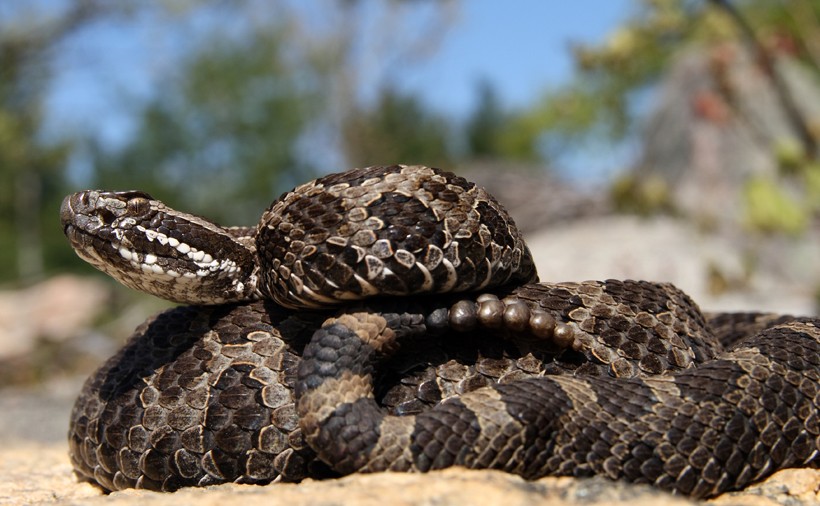
Eastern massasauga, Ontario, Canada
?
Image credits: Ryan M. Bolton/Shutterstock
Lincoln Park Zoo is part of a conservation project for restoring eastern Massasauga rattlesnake population and habitat. The Nebraska Natural Legacy Project is taking great efforts at conserving the western Massasauga rattlesnake subspecies that has been listed as ‘Threatened’ in Nebraska.
- According to the SARA Status (Schedule 1), the species has been listed as ‘Threatened’.
- The U.S. Fish & Wildlife Services currently have enlisted the Massasauga rattlesnake as a ‘Candidate’ species (requires the attention and protection of the EPA)
- The eastern Massasauga rattlesnake has been listed ‘Endangered’ in the state of Missouri.
- It is only in the state of Nebraska, the western Massasauga rattlesnake has been given a status of ‘Threatened’ to prevent habitat loss and illegal killing.
- In the state of Ontario, the eastern Massasauga rattlesnake is listed as ‘Special Concern’ which means that the species cannot be killed without a valid, certified reason.
Funfacts
- The Massasauga Rattlesnake particularly prefers grasslands that maintain wide foliage of buffalo grass and grama grasses.
- They usually make use of abandoned rodent burrows or holes created by Black-tailed prairie dogs for giving birth to young.
- Massasaugas hibernate either in a group or alone depending upon the size of the den or shelter they’ve chosen.
- "Massasauga" originates from the Chippewa tribal community meaning “great river mouth” that relates to the snake’s fundamental habitat.
- The venom of the Massasauga is a hemotoxin which means that it can easily destroy the red blood cells in the body.
- Its fangs are moveable enabling it to adjust back and forth automatically.
- The eastern Massasauga rattlesnake is the largest of the subspecies that can attain a length of 80 cm (2.6 ft) respectively.
